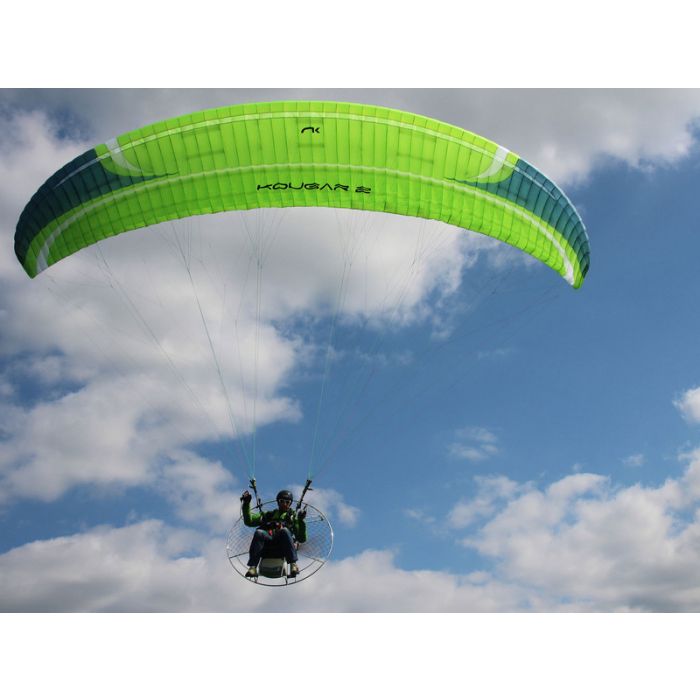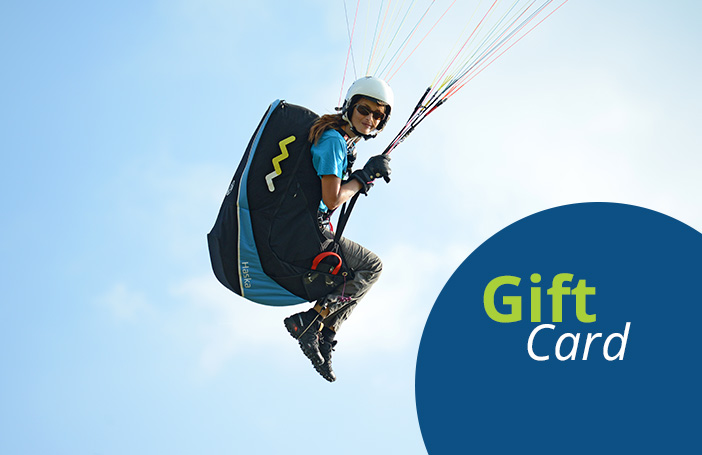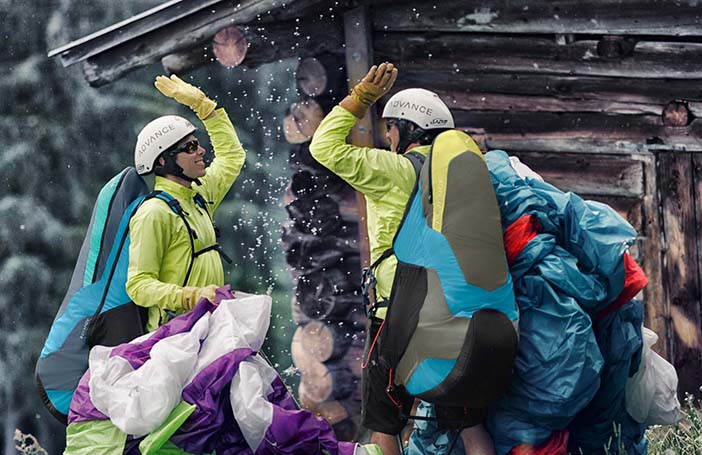Kougar 2: paramotor innovation at it's best
Optimal inflation
The Kougar 2 inflates and takes off easily. The glider comes up effortlessly overhead in all flyable weather conditions.
Reflex System Evo
An evolved Reflex System enhances the glider's abilities to perform while providing increased stability and fuel consumption optimization.
Revolutionary technology
For the first time, RAM Air Intake technology is used on a compact and comfortable Paramotor wing to promote speed with safety.
More about Kougar 2
In 2011 we decided to open a new door to the activity. The first step reached in the challenge, was to understand the Paramotor pilots needs by taking their feedback and suggestions seriously. As a result, our R&D team was then better equipped to work on a new glider concept focused on addressing the pilots concerns : better feeling and wing feedback with increased safety during flights while elevating technological advances for heightened glider performance.
Fully equipped
Knowing that experienced Paramotor pilots are always looking for fast, powerful and reliable wings enabling them to reach their goals, the Kougar 2 keeps the performance of the first generation glider but now delivers superior maximum speed with added safety.
Its ability to inflate is extraordinarily easy, thus eliminating the need for high speed during takeoff and landing. This huge advantage basically resulted from the RAM Air Intake technology used for the first time in Paramotor design.
The RAM Air Intake permits to reach an optimal air inflow configuration (below the glider's leading edge aligned with the intrados) to obtain a rapid, progressive, stable inflation. This profile modification results in more comfortable faster and tighter glider turns.
Another strong point in the Kougar 2 is the evolution of the Reflex System Profile (RSP). This innovation works together with the previous design to improve gliding, speed and safety. In addition, it cuts down on fuel consumption: less engine power is needed to obtain the same performance level, so you can set your own limits.
In terms of piloting the wing, the main toggles are more flexible and progressive, enabling for better glider control without excessive effort. An additional toggle system, connected to the stabilizer, improves glider management during accelerated flights and turns.
The Kougar 2 can be steered with the trims opened while keeping the profile stable. In other words; maintaining a high wing internal pressure with extraordinary leading edge rigidity at high speed. The glider turns without losing its handling flexibility nor its stable flight characteristics.
The wing's high performance abilities enhance the engine's power curve for a lesser workload, enabling the use of smaller size 125 and 80 cc. motors and without the need for high cubic capacity power plants.
Make the most out of this glider born to perfectly complement your flying gear. Enjoy it during extended Cross Country flights. Kougar 2, paramotor innovation at its best!
Colours: Teak; Lima
Technologies
RSP (Reflex System Profile)
The highly efficient Reflex System Profile (RSP) unlike conventional reflex designs requires less engine power to achieve greater thrust, thus resulting in lower fuel consumption, more autonomy and higher overall motor efficiency.
The RSP profile improves gliding, speed and safety.
DES (Double Effect System)
With the implementation of the DES pilot can make the most out of the glider‘s ability to perform to its full potential using the speed bar.
The DES keeps the trims in a closed position (the slowest) by default, and will open when accelerating during the flight. When the accelerator is released the DES brings the profile back to the neutral and default position.
SLE (Structured Leading Edge)
The SLE provides more rigidity and stability along the span of leading edge but also allows full flexibility along the both the vertical and horizontal axis of each open cell. The SLE ensures ease of movement on the ground and high security in the air during turbulence and whilst flying at speed.
With the SLE system there is no longer a need to use large amounts of mylar material to achieve leading edge reinforcement. This reduction in material has reduced the weight of the leading edge and the result is precise handling on the ground and easier launches.
The SLE also helps to prevent deformation of the leading edge and therefore with correct care will extend the life and efficiency of your glider.
In addition to the SLE, we work on new geometry and layout of the internal reinforcement. This new internal restructuring offers better overall cohesion of the glider and incredible stability during turbulence.
3DL (3D Leading Edge)
Adding an extra seam to the leading edge on the span axis of the glider helps to shape a compact 3D profile and have better connections to the new 3DP front panel’s layout.
When sewn together, the fabric pattern orientation and panel positioning are taken into account to avoid creases and ultimately obtain a perfect load distribution. As a result the glider profile is cleaner, to the benefit of performance and durability.
The application of this innovation to the profile is key to reaching the perfect shape from 2D to 3D.
3DP (3D Pattern Cut Optimisation)
Our paragliding and paramotor wing designs have changed significantly over time; hence considerably affecting the leading edge shape.
The latest glider generation requires a new pattern design and an optimized fabric cutting process.
The new leading edge arrangement calls for each cell panel to be manufactured independently from the others according to the final wing layout positioning, resulting in a crease-free surface with better fabric tension. We could use the analogy of a rugby ball made of different sewn individually shaped panels to obtain the perfect characteristic oval shape without wrinkles.
An optimised process is used to cut the fabric in a specific directional angle, depending on each panel’s final location. If the cloth pattern is correctly aligned with the load axis, the material is deformed to a minor degree to benefit the aerodynamic properties of the leading edge.
The application of this innovation, together with the 3DL, is key for reaching the optimal modelled form and function from 2D to 3D.
RAM Air Intake
Constant improving
Evolution and constant improving in all our products is the essence of the DNA of Niviuk’s R&D team. Thanks to the new technologies created over recent years, we have conceived new and more evolved and higher performing gliders. In this context the RAM Air Intake technology should be pointed out.
The evolution of RAM Air Intake
The RAM provides optimised internal pressure for better airflow; therefore, the glider is more compact at any angle of incidence and all trim settings. It reduces the risk of experiencing a collapse while bringing better control and stability to the overall structure. Moreover, the RAM improves the wing’s turbulence buffering ability.
Technology, a priority for Niviuk
For us, giving importance to small details means continuing working towards our goal. It means keeping focused on technology as a priority. It means provide innovation and quality to all pilots.
Technical Data
Kougar 2
|
|
|
20
|
23
|
25
|
28
|
| cells |
number |
|
60 |
60 |
60 |
60 |
| |
closed |
|
14 |
14 |
14 |
14 |
| box |
|
23 |
23 |
23 |
23 |
| flat |
area |
m2 |
20 |
23 |
25,5 |
28 |
| |
span |
m |
10,86 |
11,65 |
12,27 |
12,85 |
| aspect ratio |
|
5,9 |
5,9 |
5,9 |
5,9 |
| projected |
area |
m2 |
17,28 |
19,88 |
22,04 |
24,02 |
| |
span |
|
8,88 |
9,53 |
10,03 |
10,51 |
| aspect ratio |
|
4,56 |
4,56 |
4,56 |
4,56 |
| flattening |
|
% |
15 |
15 |
15 |
15 |
| cord |
maximum |
m |
2,25 |
2,41 |
2,54 |
2,66 |
| |
minimum |
m |
0,54 |
0,57 |
0,6 |
0,63 |
| average |
m |
1,84 |
1,97 |
2,08 |
2,18 |
| lines |
total |
m |
304 |
327 |
345 |
362 |
| |
height |
m |
6,75 |
7,25 |
7,55 |
7,99 |
| number |
|
182 |
182 |
182 |
182 |
| main |
|
2/1/3/4/1 |
2/1/3/4/1 |
2/1/3/4/1 |
2/1/3/4/1 |
| risers |
number |
4 |
A/a'/B/C/D |
A/a'/B/C/D |
A/a'/B/C/D |
A/a'/B/C/D |
| |
trims |
cm |
135 |
135 |
135 |
135 |
| accelerator |
cm |
180 |
180 |
180 |
180 |
| course correction |
|
YES |
YES |
YES |
YES |
| total weight in flight ppg |
min - max |
kg |
70-120 |
80-140 |
90-160 |
100-180 |
| total weight in flight trike |
min - max |
kg |
70-140 |
80-160 |
90-180 |
100-200 |
| glider weight |
|
kg |
5,2 |
5,8 |
6,4 |
6,8 |
| certification |
8G maximum 180kg |
EN |
EN-926-1 |
EN-926-1 |
EN-926-1 |
EN-926-1 |
| |
6G maximum 240kg |
|
DGAC |
DGAC |
DGAC |
DGAC |
| load test |
kg |
1440 |
1440 |
1440 |
1440 |
Downloads
Catalogue
Kougar 2 Eng. Fra. Esp. Ita. Deu.
Manual
Kougar 2 Eng. Fra. Esp. Deu.
Technical Data
Kougar 2 Eng. Fra. Esp.
DGAC Certification
Kougar 2 20.
Kougar 2 23.
Kougar 2 25.
Kougar 2 28.
Pilot's opinion
"This glider inflates very quick but softly and thanks to being easy turning it is so stable. I’m absolutely sure that all Paramotor pilots will be delighted with it. After taking off I was smiling… it’s a real pleasure to fly with the Kougar 2." - Karen Skinner
"The Kougar 2 has excellent handling in the entire speed range and it inflates surprisingly easy and immediately, ensuring only short low speed runs to take off. Thanks to its features we get a good fuel level consumption without forcing the engine. The new Kougar is perfect for Cross Country adventures and long flights." - Ramon Morillas
Niviuk Kougar 2 reviews
"... the Kougar 2 is a superb PPG wing with easy inflation, excellent performance (climb rate, glide, speed) and agile handling, which I can very happily recommend to experienced paramotor pilots." - Carlo Borsattino (full review)

![]()





